The SUP Essentials - it simply doesn't work without them
If you want to buy your first SUP, you'll find out pretty quickly that the board alone is not enough. In order for stand-up paddle boarding to really work (and be fun) you need some essential equipment. We explain to you what it is exactly, what you need it for and what you should look out for when buying it.
Table of Contents
1. The essentials
You can't do stand-up paddle boarding without the following accessories:
- Paddle
- Fin(s)
- Leash
- Pump
Let's get started.
2. The paddle
It is the namesake of the sport. The paddle is primarily intended for progress and navigation. This is especially noticeable in wave SUPing or in whitewater, where you have to maneuver the board quickly back and forth.
As with a SUP board, there are many different types of paddles. We explain the most important ones.

Standard SUP Paddle
2.1 Vario vs. fixed length
The Vario paddle is the most common model, as it is adjustable in length. It is especially suitable for beginners who do not yet know exactly in which disciplines they would like to be on the move. But also for families or groups where several people share a board, the Vario paddle is a good choice, because the paddle can be adjusted to the different body sizes. Another advantage of the Vario paddle is that it can be stored much smaller than a fixed length paddle. However, they tend to be a little heavier and not quite as stable as fixed length paddles.
The fixed length paddle is more for advanced SUPers, or professional athletes, as they only use this paddle for themselves and for a specific discipline. The fixed length paddles are usually a bit more stable and durable than Vario paddles, but not quite as comfortable to carry.

Paddle in fixed length
2.2 Material
Paddles are not only available in different lengths and shapes, they also come in different materials, which are suitable for different purposes. The most common materials are aluminium, fibreglass and carbon. Generally speaking, the lighter the material, the more expensive but also the better the performance of the paddle. But everything in turn.
2.2.1 Aluminium paddle
The aluminum paddle is the most robust among the paddles. With normal use, it doesn't really matter if you occasionally strike the one or other stone with it. It is perfect for whitewater and wave SUPing. This is where the stiff shaft comes into play, allowing you to catch just about any wave with a few powerful paddle strokes. But as always in life - no advantage without a disadvantage: Although the aluminum paddle is extremely robust, it is unfortunately also the heaviest.
2.2.2 Carbon paddle
The carbon paddle is the high-end product among the paddles. Compared to the aluminum paddle, it is an absolute flyweight and thus offers an enormous performance potential. Unfortunately, paddles made of carbon fiber are susceptible to impact, which is why they are used more in the field of racing and touring. Even though carbon paddles are the most expensive on the market, the price will pay for itself over the years if you take good care of it. So remember to always put the paddle back in its bag after SUPing.
2.2.3 Fiberglass paddles
They are often sold as carbon paddles, but are mostly made of a fiberglass-carbon mixture. The fiberglass paddle offers a very good price-performance ratio and is compared to the pure carbon paddle not quite as susceptible to shock. Nevertheless, you should be careful with the paddle, especially the blade should be protected. If you go paddling regularly, like touring but only have a limited budget, the fiberglass paddle is a good option for you.
2.3 Shaft flex
The flex of a paddle tells you how flexible the paddle shaft is. The bottom line is that it is a matter of taste whether you want a completely stiff, moderately firm, or a high flex paddle. But even here there is a rule of thumb which paddle is suitable for which purpose. Wave, race and touring SUPers like to use a stiff paddle - i.e. with barely noticeable flex - as this provides optimal power transfer. Because where there is hardly any flex, hardly any energy is lost.
Allrounders or beginners tend to use a paddle with higher flex. This makes paddling a little more comfortable, but it is also a little more strenuous to make progress with such a paddle, as the flex in the shaft absorbs some of the transmitted energy.
If you go for a paddle that has no flex at all, you should be aware that your musculoskeletal system - especially your shoulders - will be put under a lot of strain. So maybe go for a light flex and take care of your shoulders.
2.4 Paddle blade
Another essential component of the paddle is the paddle blade, which is defined in particular by the size or area of the blade. What surface area the blade should have depends entirely on your stature and strength. While a smaller paddle blade is suitable for women, children and lighter paddlers, larger and stronger paddlers should go for a larger blade.
Blade size is specified in "inch2" (1 inch = 2.54 cm). While large paddle blades provide more surface area to attack, they also require more effort. As a rule of thumb, women and children should choose a blade area of 75-80 inch2, ambitious paddlers about 85 inch2 and touring paddlers a blade between 85 and 90 inch2. If you are strong and / or on the raceboard, you can also choose a blade with 95 inch2 for you.
3. Fins
Just like in normal surfing, the fin setup can be discussed endlessly. For you, we have listed and described the most common variations, so that you get a general overview of what is important in the fin game.
As a general rule, every fin mounted on the SUP increases the surface and thus increases the water resistance. This has a decisive impact on the gliding properties of your SUP board.
3.1 Tracking
Since boards with only one (but then rather larger) fin offer much less surface area than with three fins, the so-called single fins are considered to be very true to track, or in a direct line. On the water this means that you can do more paddle strokes on one side before you have to change sides to go further straight. This effect is especially popular on tours or when racing. This not only saves power, but also gives you speed, which brings us directly to the next point.
3.2 Speed
As mentioned above, fins add friction in the water and therefore increase drag. Accordingly, it is obvious that the fewer and smaller the fins on the board, the higher the speeds that can be achieved on the SUP. Just remember: If you are fast, you can't steer fast! And who would have thought it, this feature is mainly used by race SUPers.
3.3 Maneuverability
Even though the word resistance has rather negative connotations, boards with three fins (thrusters) make use of it. Due to the larger and spreaded fin surface, thruster boards are much more agile and easy to turn than boards with only one fin. For this reason, wave SUPs and whitewater SUPs almost exclusively have a thruster setup.
3.4 (Tipping) stability
If you want a board that allows you to ride as stable as possible - even at low speeds - then we recommend a three-fin setup. Because of the distributed attachment points, the board is much more stable in the water than a singlefin board. Thus, unplanned weight shifts on the board are virtually "swallowed" and the SUP is less likely to wobble. This is a very useful feature, especially for whitewater SUPing, as the water is already very choppy.
3.5 The 2 + 1 setup
We have now learned that boards with only one fin are very true to track and it is easier to reach high speeds. However, these boards are less maneuverable and a bit more unstable. Predestined for this are race boards and touring boards.
On the other hand, there are wave, whitewater and yoga boards. They usually have three fins, which makes them very maneuverable and tip-resistant. However, compared to singlefin boards, these boards are less fast and less true to track.
There is also a mixed version with 2 smaller side fins and a big singlefin. They are often used on beginner or allround boards. Due to this setup, the boards are relatively stable and can still be turned relatively easily. The nice thing about this setup is that you can vary it depending on your needs. For example, you can mount only the single fin or only the two side fins. So you have maximum freedom and can use your SUP board for different purposes. Keep in mind that a single fin is mounted in a special US box. So you can not easily mount a single fin on your Thruster board.
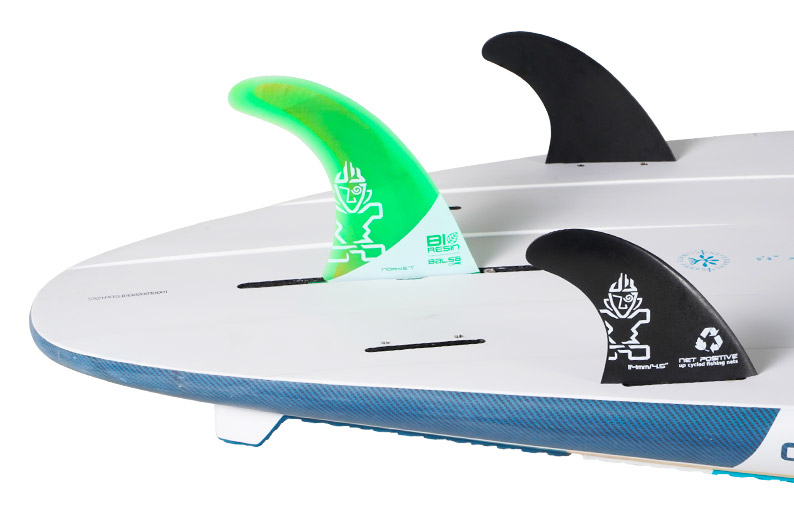
2+1 fins setup
4. Leash
The next SUP accessory we see in the essential category is the leash. It is the leash that connects you to your board. And even if many think now that it does not need such a thing - it does. Because even when SUPing, even if it's just on a small lake, the leash can save lives, especially for unsafe swimmers. But where the risk of a board dismissal is really omnipresent is in whitewater and wave SUPing. It can happen quickly that you fall into the water and bang - your board is gone! Now swim after your board through the rapids or rolling surf. Besides, there is danger not only for you, but also for the other people in the water, if the then ownerless board flows onto them. So a leash is an absolute must-have when SUPing!
But again, there are a few different models. In the next section we bring a little light into the darkness.
4.1 The components
Basically, a leash consists of three components.
- Cuff - the sleeve with which the leash is attached to the body.
- Cord - the cord is the middle piece of the leash, the actual line, it is usually made of urethane.
- Rail Saver - the connector that connects the leash to the board.
4.2 Construction
Leashes can basically be categorized into three types of construction. Which one you choose is a matter of taste.
4.2.1 The straight leash
The straight leash or also called surf leash is probably the most widely used leash on the market. It is attached to the foot and thus provides maximum freedom of movement. It is well suited for normal tours or trips on the lake and especially for wave SUPing. We recommend to attach the leash below the knee. This gives you much more control over the board during a wipeout than if you have the leash on your ankle.
4.2.2 The coiled leash
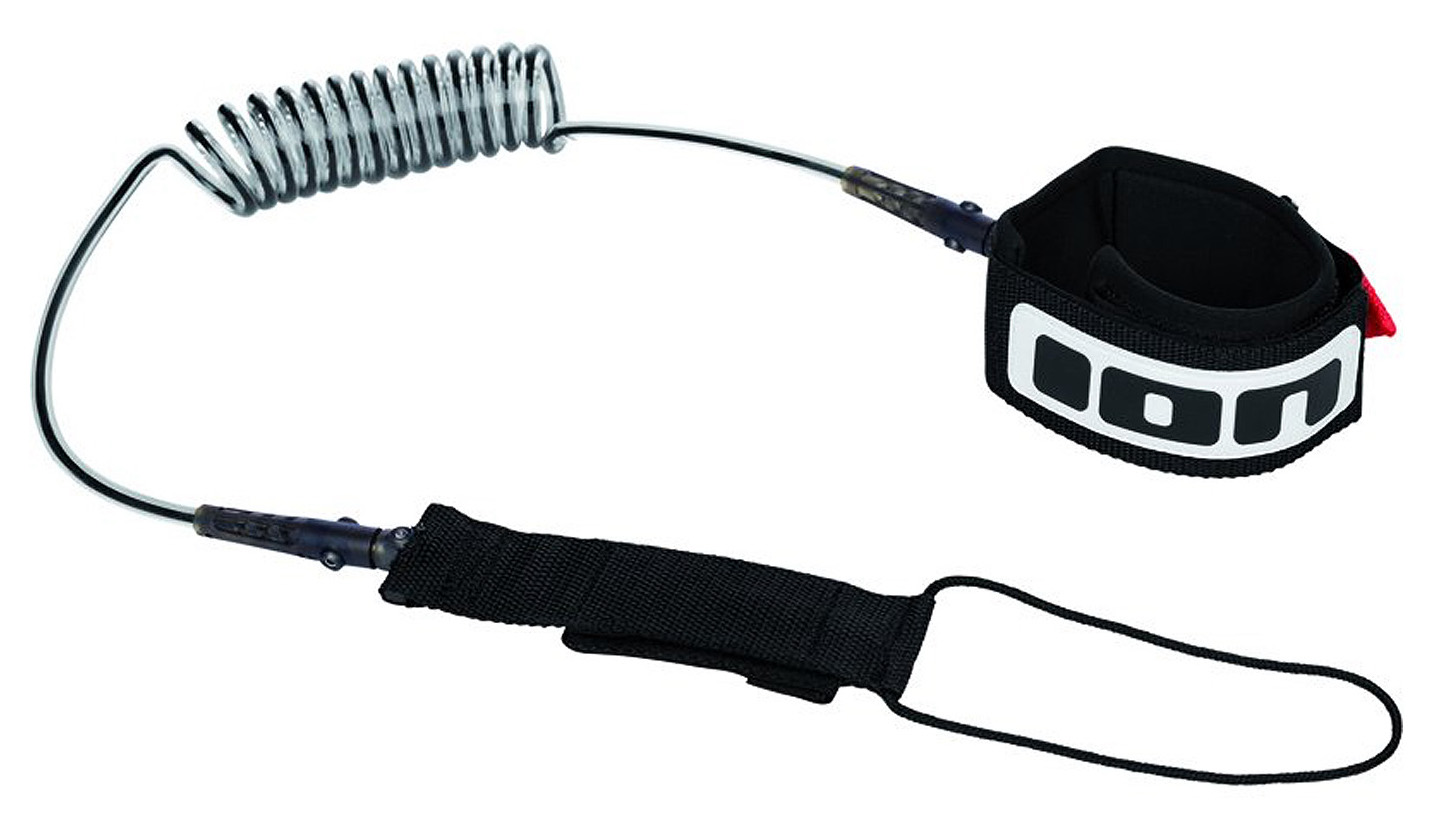
Coiled leash
The coiled leash is also attached to the foot, but the cord is wound in a spiral (similar to the cable on a telephone receiver). Thus, the leash remains continuously above water and can not get stuck on stones or water plants. This can be an advantage especially in waters with a rather low water level - e.g. when whitewater SUPing. Should you fall into the water, the leash expands. But be careful, it also contracts again, which may cause the board to buckle back.
4.2.3 The quick release leash
The quick release leash or hip leash is basically a coiled leash, which is tied around the waist. This has the advantage that you can separate yourself from the board faster in tricky situations.
Yes, we wrote above that it is important to be connected to the board at all times. But there are exceptional situations in which you should rather get rid of your board. Imagine you are on a river and your board gets tangled in the branches, or your leash gets caught somewhere... The current in the river will immediately pull you under water. You cannot swim against it. And with your hand you can reach your hip much easier than your knee, let alone your ankle. Especially when you're in the water and being tossed around. But this scenario is the absolute emergency and please do not let it stop you from being out on the SUP.
In order to give you a comprehensive insight into the world of leashes, there are two important aspects that influence a leash.
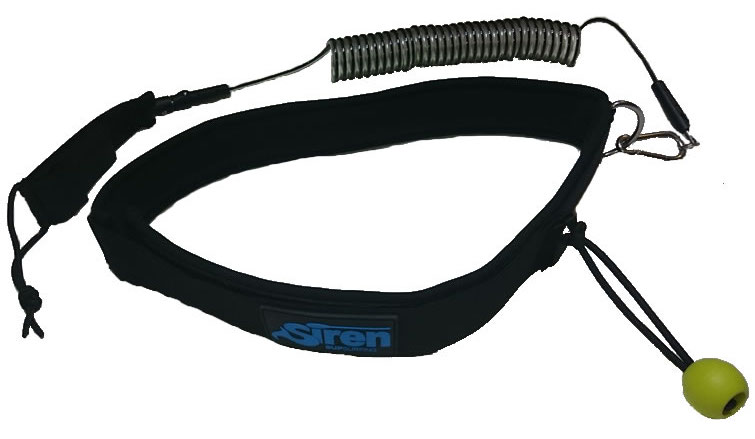
Quick release leash
4.3 The length
No matter which leash you choose, it should be about the same length as your SUP board. Coiled leashes can be slightly longer when extended. So if your board is 10'6" long, then by rule of thumb you should use a 10ft. or 11ft. leash.
4.4 The thickness
Here it also depends on the field of application. If you are sporty on a raceboard or touring board, a slightly thinner leash (approx. 6mm) is probably sufficient. However, if you are riding in waves and on wild rivers, we recommend somewhat stronger leashes (around 8 mm), so that they can better withstand the pressure of the waves or the river current.
5. Pump
Last but not least comes the pump. Yes, pure hardboard paddlers do not need a pump, but since about 90% of the boards on the market are for inflation, for us the air pump still counts as an essential accessory. We explain the differences and what you should definitely look for in a pump.
No matter which of the following pumps you choose, always make sure that the pump can reach at least the PSI prescribed for your SUP and that it has an integrated pressure gauge (pressure display).
5.1 Single stroke pump
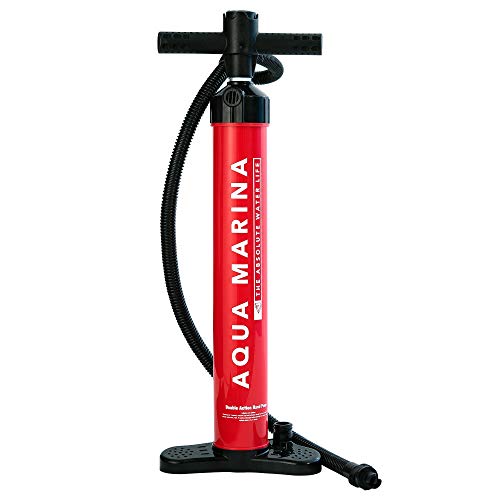
Single stroke pump
Single what pump? Single stroke pump! This means that the air flow is only in one direction, namely when pushing down the piston. It is usually included in the complete sets and is unfortunately the most inefficient pump to inflate a SUP. But even with it you get to the goal.
5.2 Double stroke pump
This pump ensures that air flows into the SUP both when pushing the piston down and when pulling it up. This saves an enormous amount of time. In addition, the double stroke pumps also have the option to switch to a single stroke mode, which is advantageous at the latest in the double-digit PSI range, because then pulling up in double stroke mode is quite exhausting.
5.3 Triple action pump
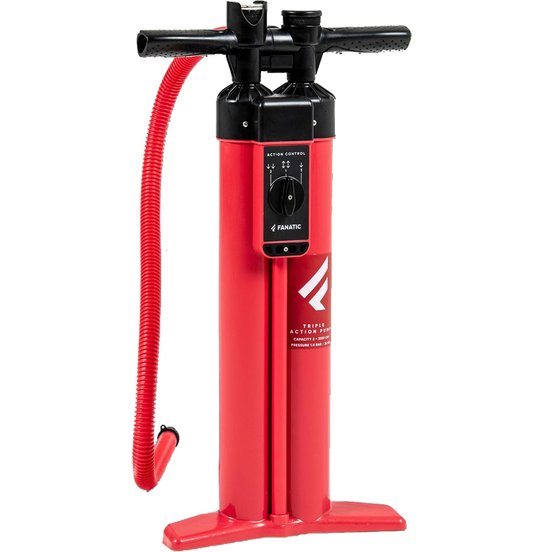
Tripple Action Pump
The triple action pump is actually identical to the double stroke pump. Like many other pumps, it has two pistons through which the air is pumped into the SUP. With this pump you can, as the name suggests, choose between three modes. The double stroke mode (analog double stroke pump) and the single stroke mode (analog single stroke pump). And in the single stroke mode lays the highlight: here you can further subdivide whether air from two or only one piston should flow into the SUP when pressing down the pump. This allows the amount of air per stroke, and thus force / time required, even more fine-tuned and individual.
5.4 Electric pump
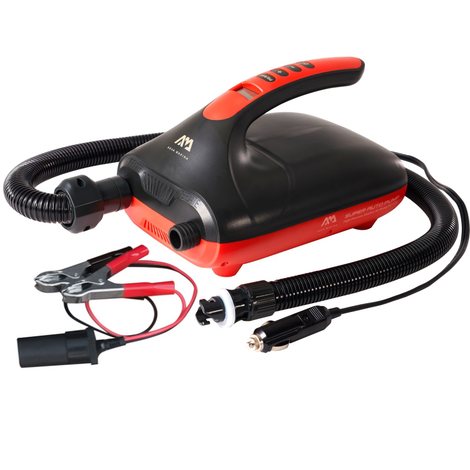
Electric pump
Then there is also the electric pump. Most electric pumps run on a 12 volt car connection (cigarette lighter), or on an external battery. This means that either your car must always be on site or you must ensure that the battery is sufficiently charged. Good electric pumps have a built-in automatic shut-off that makes the pump stop automatically as soon as a pre-defined pressure is reached in the SUP. Admittedly, the electric pump is probably the most convenient way to inflate a SUP, but is it really necessary? Moreover, it is not exactly quiet either. We at TRIPSTIX prefer one of the manual versions and see the inflation process more as a short warm-up than an annoying preparation effort.
6. Conclusion
So that was it, our guide to the SUP essentials that you should not go without. And you have probably noticed that there are very specific solutions for the different purposes. You just have to engage with it. So before you rush straight to the nearest (online) store, be aware of the requirements for which you need the essentials.
If you have any questions, suggestions or other thoughts on the topic, feel free to write us in the comments. We look forward to your feedback!






